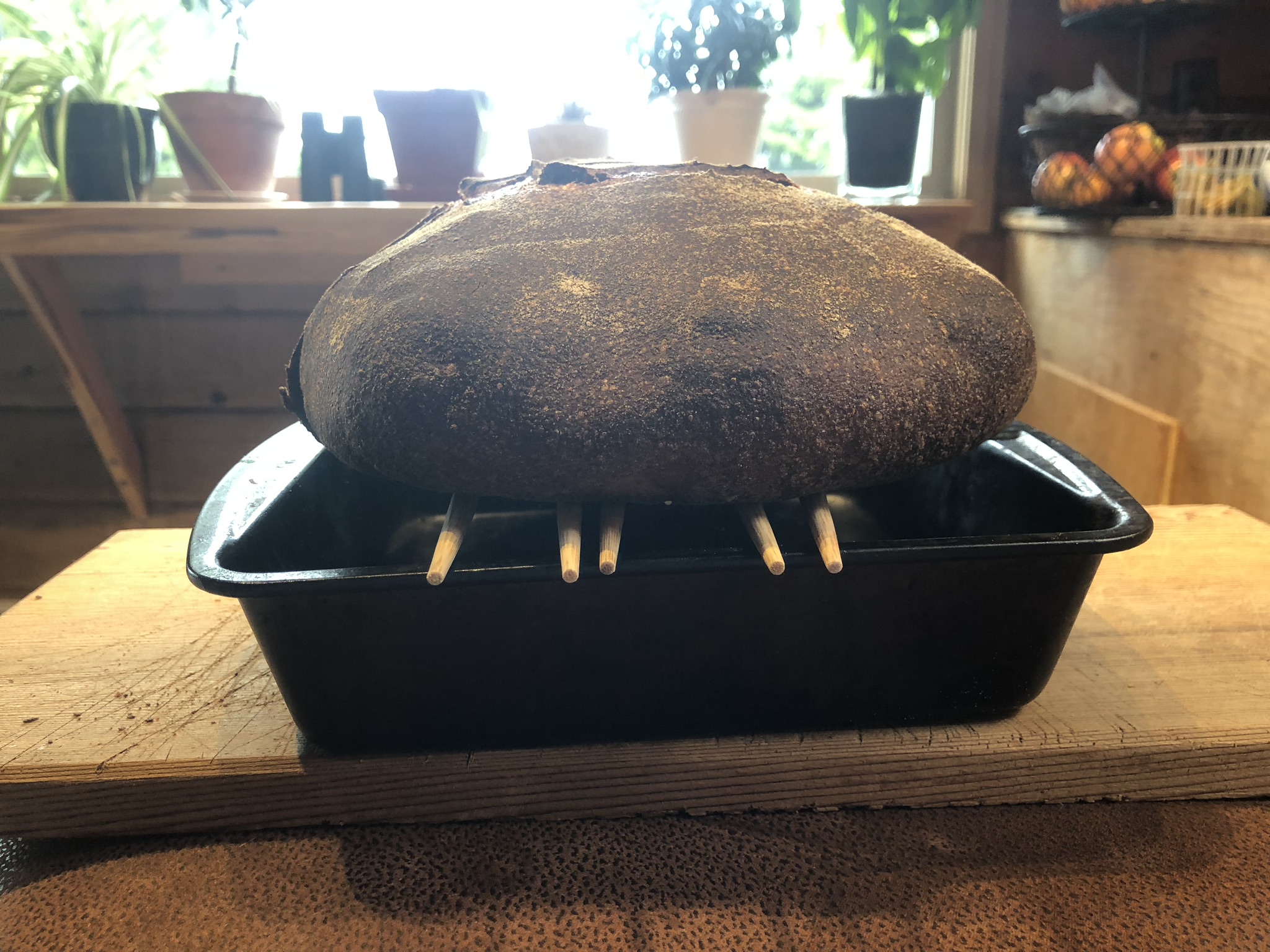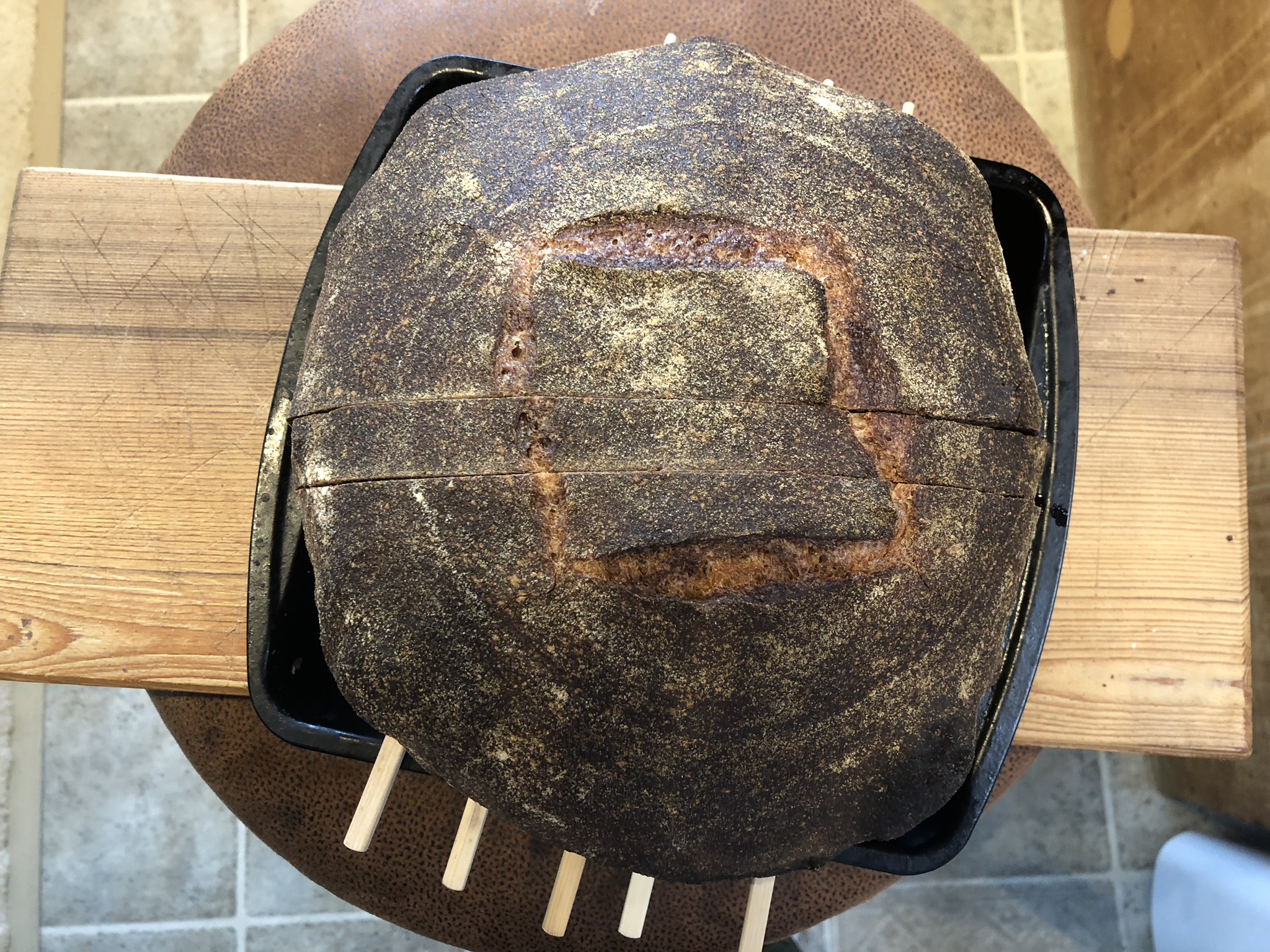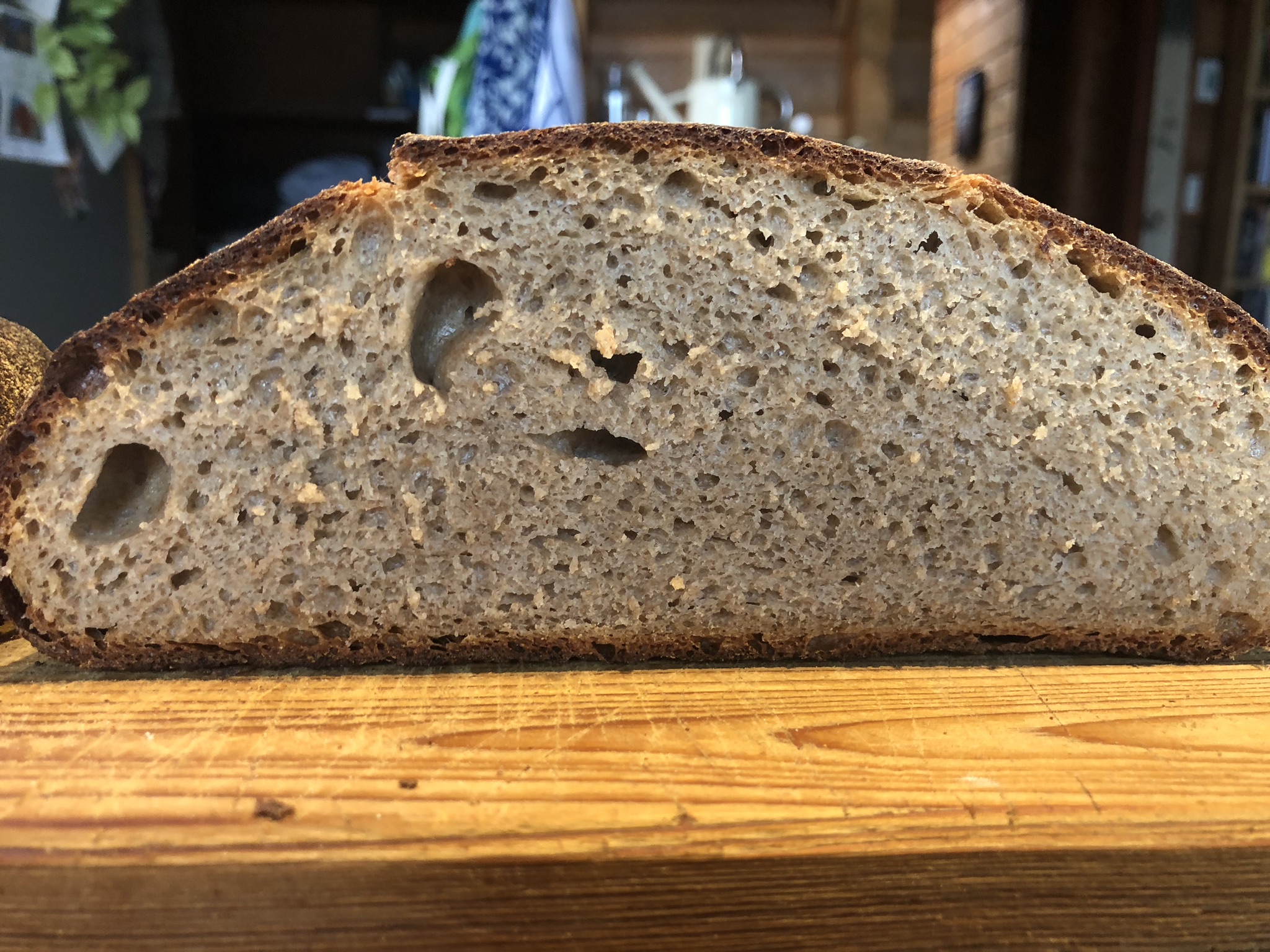Loaf:
- 79% hydration. 75% organic sprouted Anita's ww. 25% bread flour. 1.8% salt.
- Starter 9% by fermented flour baker's %. Or 18% by flour + water weight (100% hydr).
- 2hr AL. 3hr bulk w/ ST&F every 1/2 hour. 1/2 hour bench rest. Formed into tight boule. 3hr 15m proof.
- 20m 500o. 25m 425o. 5m 400o.
I dropped the loaf hard when transferring from banneton to pre-heated shallow side of DO. Rats. Need a better method. I think it degassed a bit there. Tastes good.
Side.

Top.



How can I gain a bit more height?
I think the crumb could be a bit more open but not bad?
Are the big bubbles on the outside of the crust cool as long as there are no big mouse-holes or flying-crust?
Thoughts? I'd like to improve.
Thanks.
Blue, are you aware that it is possible to insert images into the post? It makes it easier to view.
As far as the dropped loaf. <Bummer> Turn out the proofed loaf onto a piece of parchment paper. Then lift the dough by the parchment and place into the pot.
Dan
With a 75% whole wheat you are going to lose some height. Yours seems fine to me, and ditto for the crumb (the whole wheat will limit what you can do there too).
As for getting the dough into a Dutch Oven, I do not have the combo cooker, and I have tried the parchment paper approach, but I found over time that I preferred just to use my hands. Before turning the banneton over, I flour my hands, let the dough fall out of the banneton into one hand (fingers spread wide, mostly using the palm and fingers), put the banneton down and use the newly freed hand to help support the bottom of the dough, and slowly and gently place it down into the Dutch Oven. Be careful not to touch the sides of the chamber, but there is no need to be hasty. Doing this I can get the loaf to within a couple of inches of the bottom of the Dutch Oven before letting go, and I still get plenty of oven spring (sometimes even hitting the lid).
Happy baking.
Thanks for the comments. I have used the flip-to-one-hand method with decent success and I think I'll go back. For me, there is something aesthetically preferable to not using the parchment paper method.
Given that there are a few larger holes around a much more even smaller holed crumb, I'm wondering if the the loaf was a bit underproofed.
One other benefit of not using parchment paper is that I can sprinkle a light coating of semolina flour on the bottom of the Dutch Oven before placing the dough inside. The semolina provides a nice flavor and texture to the bottom of the baked loaf.
I'm just not sure if I should ferment for a 1/2 hour more. I'm thinking it might be underproofed.
I am probably the last one that should give advice, since I normally overproof, except when I underproof, but the only way to be sure with WW is to try. So next loaf, try to maintain everything the same, including the temps, and wait a half hour longer and check the results. You will know you are getting to overproof stage when you take the cover of the DO off and you have a nice oven spring, but when you come back to take it out of the oven at the final stage, it has diminished in height.
I just had a lovely comment and suggestions erased trying to post. So frustrating! So the baked down version:
Lovely crumb and crust colour. A beautiful bold bake!
height, more, ideas:
Thanks for re-writing after having it vaporized. I'll consider some of these options. I'm doing even less upfront bowl kneading today; no AL but a 50m all ingredients ex-salt mix; 5% less starter; 82% hydr; will space out a few more folds later into the BF. See if it reflects in the crumb and height.
Thoughts from one who bakes 60% ww sd every week:
That you haven't provided the temperatures of your autolyse, bulk or proof suggests that you are not paying particularly close attention to an essential element of your process. Temperature (and its conjoined twin, time) is arguably the ingredient to which closest attention should be paid.
I don't know how 'alive' (fresh) the whole wheat flour is that you're using. Our freshly milled flour is enzymatically (read: proteolytically) very active. Overly long and/or warm fermentation weakens the dough/gluten with the expected effects on oven spring and ultimate loft. 3.5h is a long final proof, unless at retarding temperature of course.
Lower hydration levains provide greater loaf support (stronger gluten), so you might consider dropping your levain hydration (to 70 or 80%).
If you're using literally "bread flour" at 25%, you might consider a lower protein AP, since higher protein bread flours do not allow as open a crumb as lower protein alternatives and your crumb may be denser than you'd prefer.
Nine percent levain, while fashionably Robertsonian, requires a longer fermentation than would suffice for higher levels (15 or 20%), thereby providing less time for your active ww flour's proteases to team up with the bran to doubly wham the dough's gluten, reducing spring and loft.
Here is some 75% whole wheat inspiration from deep in the recesses of the TFL archive.
Happy Whole Wheat Baking,
Tom
You wrote, “Lower hydration levains provide greater loaf support (stronger gluten)”.
I don’t doubt that statement, but I would really like to understand it. Please explain how/why that works.
Dan
”inquiring minds want to know”
Dan, Good question and you have every right and reason to doubt such an assertion without more support than I gave (= none). I wish I could provide a citation for chemical/biological support. But I cannot, beyond the usual 'it's accepted wisdom'. The best explanation I've heard, and the one I've retained owing to its logic, is that lower hydration levains produce more acid (why? products of bacterial stress metabolism?) which, as is well accepted, strengthens gluten. Empirically, I can report that whenever I get tempted to use liquid levain for my weekly 2k miche, I find that the presumed flavor benefit (sweeter) rarely outweighs the cost in spring and loft. But there are always enough other variables involved that I can't unequivocally attribute structural changes to levain hydration. I'm just not that scientific about it. For example, I rarely bother to maintain the overall formula hydration when I increase levain hydration to 100%. And there are the inevitable week to week tweaks and caprices with other dough additions not to mention changing seasons and kitchen temperatures. Proper experiments in bread baking require more stringently controlled conditions than we have in our home kitchens, not to mention more oven space!
Tom
If it wasn't dumped, I would immediately say it is over proofed because there was no bloom but if dumped it could do the same thing Whole grain breads like this one need to go in the heat at 85% proof. I always upend the dough onto a peel with parchment between them. It then slides easily into the Combo Cooker or more easily into the a DO after scoring. So we don't know for sure
Happy baking
I benefited a lot from the granular thoughts on ww, hydration, gluten strength. Good stuff.
I'm ignoring the monitoring of temp for now. Seeing how well I can do without it. Sometimes I prefer minimalism as an aesthetic and I'll suffer the trade-off of less precision, perhaps less consistency in results. I'll gauge the progress of fermentation via rise, aroma, alveoli, texture, tension, extension.
Linking to a new loaf baked yesterday sliced today. Changed little and that makes me think the loaf above was underproofed. I got more height, more open crumb, no density in the middle. Looking forward to the discussion and I have a lot of questions about ww, ratios, hydration, gluten.